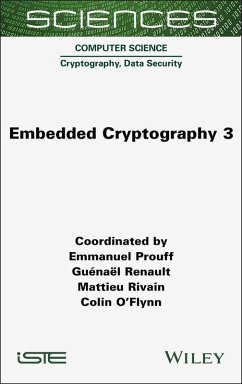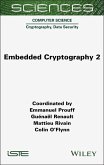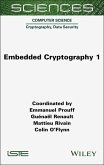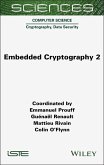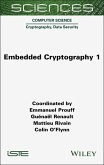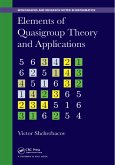142,99 €
142,99 €
inkl. MwSt.
Sofort per Download lieferbar

0 °P sammeln
142,99 €
Als Download kaufen

142,99 €
inkl. MwSt.
Sofort per Download lieferbar

0 °P sammeln
Jetzt verschenken
Alle Infos zum eBook verschenken
142,99 €
inkl. MwSt.
Sofort per Download lieferbar
Alle Infos zum eBook verschenken

0 °P sammeln
- Format: PDF
- Merkliste
- Auf die Merkliste
- Bewerten Bewerten
- Teilen
- Produkt teilen
- Produkterinnerung
- Produkterinnerung

Bitte loggen Sie sich zunächst in Ihr Kundenkonto ein oder registrieren Sie sich bei
bücher.de, um das eBook-Abo tolino select nutzen zu können.
Hier können Sie sich einloggen
Hier können Sie sich einloggen
Sie sind bereits eingeloggt. Klicken Sie auf 2. tolino select Abo, um fortzufahren.

Bitte loggen Sie sich zunächst in Ihr Kundenkonto ein oder registrieren Sie sich bei bücher.de, um das eBook-Abo tolino select nutzen zu können.
Embedded Cryptography provides a comprehensive exploration of cryptographic techniques tailored for embedded systems, addressing the growing importance of security in devices such as mobile systems and IoT. The books explore the evolution of embedded cryptography since its inception in the mid-90s and cover both theoretical and practical aspects, as well as discussing the implementation of cryptographic algorithms such as AES, RSA, ECC and post-quantum algorithms.
The work is structured into three volumes, spanning forty chapters and nine parts, and is enriched with pedagogical materials…mehr
- Geräte: PC
- mit Kopierschutz
- eBook Hilfe
- Größe: 30.83MB
Andere Kunden interessierten sich auch für
![Embedded Cryptography 2 (eBook, PDF) Embedded Cryptography 2 (eBook, PDF)]() Emmanuel ProuffEmbedded Cryptography 2 (eBook, PDF)142,99 €
Emmanuel ProuffEmbedded Cryptography 2 (eBook, PDF)142,99 €![Embedded Cryptography 1 (eBook, PDF) Embedded Cryptography 1 (eBook, PDF)]() Emmanuel ProuffEmbedded Cryptography 1 (eBook, PDF)142,99 €
Emmanuel ProuffEmbedded Cryptography 1 (eBook, PDF)142,99 €![Embedded Cryptography 2 (eBook, ePUB) Embedded Cryptography 2 (eBook, ePUB)]() Emmanuel ProuffEmbedded Cryptography 2 (eBook, ePUB)142,99 €
Emmanuel ProuffEmbedded Cryptography 2 (eBook, ePUB)142,99 €![Embedded Cryptography 1 (eBook, ePUB) Embedded Cryptography 1 (eBook, ePUB)]() Emmanuel ProuffEmbedded Cryptography 1 (eBook, ePUB)142,99 €
Emmanuel ProuffEmbedded Cryptography 1 (eBook, ePUB)142,99 €![Elements of Quasigroup Theory and Applications (eBook, PDF) Elements of Quasigroup Theory and Applications (eBook, PDF)]() Victor ShcherbacovElements of Quasigroup Theory and Applications (eBook, PDF)52,95 €
Victor ShcherbacovElements of Quasigroup Theory and Applications (eBook, PDF)52,95 €![Cryptography (eBook, PDF) Cryptography (eBook, PDF)]() Douglas Robert StinsonCryptography (eBook, PDF)46,95 €
Douglas Robert StinsonCryptography (eBook, PDF)46,95 €![Secret History (eBook, PDF) Secret History (eBook, PDF)]() Craig P. BauerSecret History (eBook, PDF)58,95 €
Craig P. BauerSecret History (eBook, PDF)58,95 €-
-
-
Embedded Cryptography provides a comprehensive exploration of cryptographic techniques tailored for embedded systems, addressing the growing importance of security in devices such as mobile systems and IoT. The books explore the evolution of embedded cryptography since its inception in the mid-90s and cover both theoretical and practical aspects, as well as discussing the implementation of cryptographic algorithms such as AES, RSA, ECC and post-quantum algorithms.
The work is structured into three volumes, spanning forty chapters and nine parts, and is enriched with pedagogical materials and real-world case studies, designed for researchers, professionals, and students alike, offering insights into both foundational and advanced topics in the field.
Embedded Cryptography 3 is dedicated to white-box cryptography, randomness and key generation, as well as real world applications and attacks in the wild.
The work is structured into three volumes, spanning forty chapters and nine parts, and is enriched with pedagogical materials and real-world case studies, designed for researchers, professionals, and students alike, offering insights into both foundational and advanced topics in the field.
Embedded Cryptography 3 is dedicated to white-box cryptography, randomness and key generation, as well as real world applications and attacks in the wild.
Dieser Download kann aus rechtlichen Gründen nur mit Rechnungsadresse in D ausgeliefert werden.
Produktdetails
- Produktdetails
- Verlag: John Wiley & Sons
- Seitenzahl: 341
- Erscheinungstermin: 10. Januar 2025
- Englisch
- ISBN-13: 9781394351916
- Artikelnr.: 72805728
- Verlag: John Wiley & Sons
- Seitenzahl: 341
- Erscheinungstermin: 10. Januar 2025
- Englisch
- ISBN-13: 9781394351916
- Artikelnr.: 72805728
- Herstellerkennzeichnung Die Herstellerinformationen sind derzeit nicht verfügbar.
Emmanuel Prouff is a researcher in Applied Cryptography and Embedded Security. He has worked as an expert for ANSSI, France, as well as for major security companies such as IDEMIA and SAFRAN, both to develop secure implementations against physical attacks.
Guénaël Renault is Deputy Head of the Hardware Security Lab at ANSSI, France. His research interests include cryptography, algebraic (symbolic) computation and computational number theory.
Mattieu Rivain is a researcher and entrepreneur in Cryptography, currently working as CEO at CryptoExperts, France. His research interests include provable security against side-channel attacks, white-box cryptography, zero-knowledge proofs and post-quantum signatures.
Colin O'Flynn is Assistant Professor in Embedded Hardware Security at Dalhousie University, Canada. His interests include embedded hardware security, PCB design and prototype construction.
Guénaël Renault is Deputy Head of the Hardware Security Lab at ANSSI, France. His research interests include cryptography, algebraic (symbolic) computation and computational number theory.
Mattieu Rivain is a researcher and entrepreneur in Cryptography, currently working as CEO at CryptoExperts, France. His research interests include provable security against side-channel attacks, white-box cryptography, zero-knowledge proofs and post-quantum signatures.
Colin O'Flynn is Assistant Professor in Embedded Hardware Security at Dalhousie University, Canada. His interests include embedded hardware security, PCB design and prototype construction.
Preface xiii
Emmanuel PROUFF, Guénaël RENAULT, Matthieu RIVAIN and Colin O'FLYNN
Part 1. White-Box Cryptography 1
Chapter 1. Introduction to White-Box Cryptography 3
Pierre GALISSANT and Louis GOUBIN
1.1. Introductory remarks 3
1.2. Basic notions for white-box cryptography 6
1.3. Proposed (and broken) solutions 9
1.4. Generic strategies to build white-box implementations 12
1.5. Applications of white-box cryptography 15
1.6. Notes and further references 17
1.7. References 19
Chapter 2. Gray-Box Attacks against White-Box Implementations 23
Aleksei UDOVENKO
2.1. Introduction 23
2.2. Specifics of white-box side-channels 24
2.3. Fault injections 30
2.4. Exact matching attack 35
2.5. Linear decoding analysis/algebraic attacks 39
2.6. Countermeasures against the algebraic attack 43
2.7. Conclusions 49
2.8. Notes and further references 50
2.9. References 50
Chapter 3. Tools for White-Box Cryptanalysis 53
Philippe TEUWEN
3.1. Introduction 53
3.2. Tracing programs 55
3.3. Target recognition 57
3.4. Acquiring traces for side-channel analysis 59
3.5. Preprocessing traces 61
3.6. Differential computation analysis 62
3.7. Linear decoding analysis also known as algebraic attack 64
3.8. Injecting faults 65
3.9. Differential fault analysis 67
3.10. Coping with external encodings 69
3.11. Conclusion 70
3.12. Notes and further references 70
3.13. References 72
Chapter 4. Code Obfuscation 73
Sebastian SCHRITTWIESER and Stefan KATZENBEISSER
4.1. Introduction 73
4.2. Obfuscation methods 76
4.3. Attacks against obfuscation 85
4.4. Application of code obfuscation 87
4.5. Conclusions 89
4.6. Notes and further references 89
4.7. References 90
Part 2. Randomness and Key Generation 93
Chapter 5. True Random Number Generation 95
Viktor FISCHER, Florent BERNARD and Patrick HADDAD
5.1. Introduction 95
5.2. TRNG design 96
5.3. Randomness and sources of randomness 97
5.4. Randomness extraction and digitization 100
5.5. Post-processing of the raw binary signal 104
5.6. Stochastic modeling and entropy rate management of the TRNG 105
5.7. TRNG testing and testing strategies 109
5.8. Conclusion 113
5.9. Notes and further references 113
5.10. References 114
Chapter 6. Pseudorandom Number Generation 115
Jean-René REINHARD and Sylvain RUHAULT
6.1. Introduction 115
6.2. PRNG with ideal noise source 116
6.3. PRNG with imperfect noise sources 121
6.4. Standard PRNG with inputs 125
6.5. Notes and further references 128
6.6. References 129
Chapter 7. Prime Number Generation and RSA Keys 131
Marc JOYE and Pascal PAILLIER
7.1. Introduction 131
7.2. Primality testing methods 133
7.3. Generation of random units 133
7.4. Generation of random primes 136
7.5. RSA key generation 140
7.6. Exercises 143
7.7. Notes and further references 144
7.8. References 146
Chapter 8. Nonce Generation for Discrete Logarithm-Based Signatures 151
Akira TAKAHASHI and Mehdi TIBOUCHI
8.1. Introduction 151
8.2. The hidden number problem and randomness failures 153
8.3. Lattice attacks 154
8.4. Fourier transform attack 160
8.5. Preventing randomness failures 166
8.6. Notes and further references 167
8.7. Acknowledgment 169
8.8. References 169
Chapter 9. Random Error Distributions in Post-Quantum Schemes 173
Thomas PREST
9.1. Introduction 173
9.2. Why post-quantum schemes need random errors 174
9.3. Distributions for random errors 178
9.4. Sampling algorithms 184
9.5. Notes and further references 193
9.6. References 197
Part 3. Real-World Applications 203
Chapter 10. ROCA and Minerva Vulnerabilities 205
Jan JANCAR, Petr SVENDA and Marek SYS
10.1. The Return of Coppersmith's Attack 206
10.2. Minerva 216
10.3. References 222
Chapter 11. Security of Automotive Systems 225
Lennert WOUTERS, Benedikt GIERLICHS and Bart PRENEEL
11.1. Introduction 225
11.2. The embedded automotive attacker 226
11.3. An overview of automotive attacks 227
11.4. Application of physical attacks in automotive security 231
11.5. Case study: Tesla Model X keyless entry system 233
11.6. Conclusion 237
11.7. References 237
Chapter 12. Practical Full Key Recovery on a Google Titan Security Key 245
Laurent IMBERT, Victor LOMNE, Camille MUTCHLER and Thomas ROCHE
12.1. Introduction 245
12.2. Preliminaries 246
12.3. Reverse-engineering and vulnerability of the ECDSA algorithm 249
12.4. A key-recovery attack 252
12.5. Take-home message 255
12.6. References 255
Chapter 13. An Introduction to Intentional Electromagnetic Interference
Exploitation 257
José LOPES ESTEVES
13.1. IEMI: history and definition 257
13.2. Information security threats related to electromagnetic
susceptibility 259
13.3. Electromagnetic fault injection 260
13.4. Destruction, denial of service 261
13.5. Denial of service on radio front-ends 261
13.6. Signal injection in communication interfaces 262
13.7. Signal injection attacks on sensors and actuators 262
13.8. IEMI-covert channel 263
13.9. Electromagnetic watermarking 269
13.10. Conclusion 273
13.11. References 274
Chapter 14. Attacking IoT Light Bulbs 279
Colin O'FLYNN and Eyal RONEN
14.1. Introduction 279
14.2. Preliminaries 280
14.3. Hardware AES and AES-CTR attacks 282
14.4. AES-CCM bootloader attack 286
14.5. Application of attack 293
14.6. Notes and further references 294
14.7. References 295
List of Authors 297
Index 301
Summary of Volume 1 305
Summary of Volume 2 313
Emmanuel PROUFF, Guénaël RENAULT, Matthieu RIVAIN and Colin O'FLYNN
Part 1. White-Box Cryptography 1
Chapter 1. Introduction to White-Box Cryptography 3
Pierre GALISSANT and Louis GOUBIN
1.1. Introductory remarks 3
1.2. Basic notions for white-box cryptography 6
1.3. Proposed (and broken) solutions 9
1.4. Generic strategies to build white-box implementations 12
1.5. Applications of white-box cryptography 15
1.6. Notes and further references 17
1.7. References 19
Chapter 2. Gray-Box Attacks against White-Box Implementations 23
Aleksei UDOVENKO
2.1. Introduction 23
2.2. Specifics of white-box side-channels 24
2.3. Fault injections 30
2.4. Exact matching attack 35
2.5. Linear decoding analysis/algebraic attacks 39
2.6. Countermeasures against the algebraic attack 43
2.7. Conclusions 49
2.8. Notes and further references 50
2.9. References 50
Chapter 3. Tools for White-Box Cryptanalysis 53
Philippe TEUWEN
3.1. Introduction 53
3.2. Tracing programs 55
3.3. Target recognition 57
3.4. Acquiring traces for side-channel analysis 59
3.5. Preprocessing traces 61
3.6. Differential computation analysis 62
3.7. Linear decoding analysis also known as algebraic attack 64
3.8. Injecting faults 65
3.9. Differential fault analysis 67
3.10. Coping with external encodings 69
3.11. Conclusion 70
3.12. Notes and further references 70
3.13. References 72
Chapter 4. Code Obfuscation 73
Sebastian SCHRITTWIESER and Stefan KATZENBEISSER
4.1. Introduction 73
4.2. Obfuscation methods 76
4.3. Attacks against obfuscation 85
4.4. Application of code obfuscation 87
4.5. Conclusions 89
4.6. Notes and further references 89
4.7. References 90
Part 2. Randomness and Key Generation 93
Chapter 5. True Random Number Generation 95
Viktor FISCHER, Florent BERNARD and Patrick HADDAD
5.1. Introduction 95
5.2. TRNG design 96
5.3. Randomness and sources of randomness 97
5.4. Randomness extraction and digitization 100
5.5. Post-processing of the raw binary signal 104
5.6. Stochastic modeling and entropy rate management of the TRNG 105
5.7. TRNG testing and testing strategies 109
5.8. Conclusion 113
5.9. Notes and further references 113
5.10. References 114
Chapter 6. Pseudorandom Number Generation 115
Jean-René REINHARD and Sylvain RUHAULT
6.1. Introduction 115
6.2. PRNG with ideal noise source 116
6.3. PRNG with imperfect noise sources 121
6.4. Standard PRNG with inputs 125
6.5. Notes and further references 128
6.6. References 129
Chapter 7. Prime Number Generation and RSA Keys 131
Marc JOYE and Pascal PAILLIER
7.1. Introduction 131
7.2. Primality testing methods 133
7.3. Generation of random units 133
7.4. Generation of random primes 136
7.5. RSA key generation 140
7.6. Exercises 143
7.7. Notes and further references 144
7.8. References 146
Chapter 8. Nonce Generation for Discrete Logarithm-Based Signatures 151
Akira TAKAHASHI and Mehdi TIBOUCHI
8.1. Introduction 151
8.2. The hidden number problem and randomness failures 153
8.3. Lattice attacks 154
8.4. Fourier transform attack 160
8.5. Preventing randomness failures 166
8.6. Notes and further references 167
8.7. Acknowledgment 169
8.8. References 169
Chapter 9. Random Error Distributions in Post-Quantum Schemes 173
Thomas PREST
9.1. Introduction 173
9.2. Why post-quantum schemes need random errors 174
9.3. Distributions for random errors 178
9.4. Sampling algorithms 184
9.5. Notes and further references 193
9.6. References 197
Part 3. Real-World Applications 203
Chapter 10. ROCA and Minerva Vulnerabilities 205
Jan JANCAR, Petr SVENDA and Marek SYS
10.1. The Return of Coppersmith's Attack 206
10.2. Minerva 216
10.3. References 222
Chapter 11. Security of Automotive Systems 225
Lennert WOUTERS, Benedikt GIERLICHS and Bart PRENEEL
11.1. Introduction 225
11.2. The embedded automotive attacker 226
11.3. An overview of automotive attacks 227
11.4. Application of physical attacks in automotive security 231
11.5. Case study: Tesla Model X keyless entry system 233
11.6. Conclusion 237
11.7. References 237
Chapter 12. Practical Full Key Recovery on a Google Titan Security Key 245
Laurent IMBERT, Victor LOMNE, Camille MUTCHLER and Thomas ROCHE
12.1. Introduction 245
12.2. Preliminaries 246
12.3. Reverse-engineering and vulnerability of the ECDSA algorithm 249
12.4. A key-recovery attack 252
12.5. Take-home message 255
12.6. References 255
Chapter 13. An Introduction to Intentional Electromagnetic Interference
Exploitation 257
José LOPES ESTEVES
13.1. IEMI: history and definition 257
13.2. Information security threats related to electromagnetic
susceptibility 259
13.3. Electromagnetic fault injection 260
13.4. Destruction, denial of service 261
13.5. Denial of service on radio front-ends 261
13.6. Signal injection in communication interfaces 262
13.7. Signal injection attacks on sensors and actuators 262
13.8. IEMI-covert channel 263
13.9. Electromagnetic watermarking 269
13.10. Conclusion 273
13.11. References 274
Chapter 14. Attacking IoT Light Bulbs 279
Colin O'FLYNN and Eyal RONEN
14.1. Introduction 279
14.2. Preliminaries 280
14.3. Hardware AES and AES-CTR attacks 282
14.4. AES-CCM bootloader attack 286
14.5. Application of attack 293
14.6. Notes and further references 294
14.7. References 295
List of Authors 297
Index 301
Summary of Volume 1 305
Summary of Volume 2 313
Preface xiii
Emmanuel PROUFF, Guénaël RENAULT, Matthieu RIVAIN and Colin O'FLYNN
Part 1. White-Box Cryptography 1
Chapter 1. Introduction to White-Box Cryptography 3
Pierre GALISSANT and Louis GOUBIN
1.1. Introductory remarks 3
1.2. Basic notions for white-box cryptography 6
1.3. Proposed (and broken) solutions 9
1.4. Generic strategies to build white-box implementations 12
1.5. Applications of white-box cryptography 15
1.6. Notes and further references 17
1.7. References 19
Chapter 2. Gray-Box Attacks against White-Box Implementations 23
Aleksei UDOVENKO
2.1. Introduction 23
2.2. Specifics of white-box side-channels 24
2.3. Fault injections 30
2.4. Exact matching attack 35
2.5. Linear decoding analysis/algebraic attacks 39
2.6. Countermeasures against the algebraic attack 43
2.7. Conclusions 49
2.8. Notes and further references 50
2.9. References 50
Chapter 3. Tools for White-Box Cryptanalysis 53
Philippe TEUWEN
3.1. Introduction 53
3.2. Tracing programs 55
3.3. Target recognition 57
3.4. Acquiring traces for side-channel analysis 59
3.5. Preprocessing traces 61
3.6. Differential computation analysis 62
3.7. Linear decoding analysis also known as algebraic attack 64
3.8. Injecting faults 65
3.9. Differential fault analysis 67
3.10. Coping with external encodings 69
3.11. Conclusion 70
3.12. Notes and further references 70
3.13. References 72
Chapter 4. Code Obfuscation 73
Sebastian SCHRITTWIESER and Stefan KATZENBEISSER
4.1. Introduction 73
4.2. Obfuscation methods 76
4.3. Attacks against obfuscation 85
4.4. Application of code obfuscation 87
4.5. Conclusions 89
4.6. Notes and further references 89
4.7. References 90
Part 2. Randomness and Key Generation 93
Chapter 5. True Random Number Generation 95
Viktor FISCHER, Florent BERNARD and Patrick HADDAD
5.1. Introduction 95
5.2. TRNG design 96
5.3. Randomness and sources of randomness 97
5.4. Randomness extraction and digitization 100
5.5. Post-processing of the raw binary signal 104
5.6. Stochastic modeling and entropy rate management of the TRNG 105
5.7. TRNG testing and testing strategies 109
5.8. Conclusion 113
5.9. Notes and further references 113
5.10. References 114
Chapter 6. Pseudorandom Number Generation 115
Jean-René REINHARD and Sylvain RUHAULT
6.1. Introduction 115
6.2. PRNG with ideal noise source 116
6.3. PRNG with imperfect noise sources 121
6.4. Standard PRNG with inputs 125
6.5. Notes and further references 128
6.6. References 129
Chapter 7. Prime Number Generation and RSA Keys 131
Marc JOYE and Pascal PAILLIER
7.1. Introduction 131
7.2. Primality testing methods 133
7.3. Generation of random units 133
7.4. Generation of random primes 136
7.5. RSA key generation 140
7.6. Exercises 143
7.7. Notes and further references 144
7.8. References 146
Chapter 8. Nonce Generation for Discrete Logarithm-Based Signatures 151
Akira TAKAHASHI and Mehdi TIBOUCHI
8.1. Introduction 151
8.2. The hidden number problem and randomness failures 153
8.3. Lattice attacks 154
8.4. Fourier transform attack 160
8.5. Preventing randomness failures 166
8.6. Notes and further references 167
8.7. Acknowledgment 169
8.8. References 169
Chapter 9. Random Error Distributions in Post-Quantum Schemes 173
Thomas PREST
9.1. Introduction 173
9.2. Why post-quantum schemes need random errors 174
9.3. Distributions for random errors 178
9.4. Sampling algorithms 184
9.5. Notes and further references 193
9.6. References 197
Part 3. Real-World Applications 203
Chapter 10. ROCA and Minerva Vulnerabilities 205
Jan JANCAR, Petr SVENDA and Marek SYS
10.1. The Return of Coppersmith's Attack 206
10.2. Minerva 216
10.3. References 222
Chapter 11. Security of Automotive Systems 225
Lennert WOUTERS, Benedikt GIERLICHS and Bart PRENEEL
11.1. Introduction 225
11.2. The embedded automotive attacker 226
11.3. An overview of automotive attacks 227
11.4. Application of physical attacks in automotive security 231
11.5. Case study: Tesla Model X keyless entry system 233
11.6. Conclusion 237
11.7. References 237
Chapter 12. Practical Full Key Recovery on a Google Titan Security Key 245
Laurent IMBERT, Victor LOMNE, Camille MUTCHLER and Thomas ROCHE
12.1. Introduction 245
12.2. Preliminaries 246
12.3. Reverse-engineering and vulnerability of the ECDSA algorithm 249
12.4. A key-recovery attack 252
12.5. Take-home message 255
12.6. References 255
Chapter 13. An Introduction to Intentional Electromagnetic Interference
Exploitation 257
José LOPES ESTEVES
13.1. IEMI: history and definition 257
13.2. Information security threats related to electromagnetic
susceptibility 259
13.3. Electromagnetic fault injection 260
13.4. Destruction, denial of service 261
13.5. Denial of service on radio front-ends 261
13.6. Signal injection in communication interfaces 262
13.7. Signal injection attacks on sensors and actuators 262
13.8. IEMI-covert channel 263
13.9. Electromagnetic watermarking 269
13.10. Conclusion 273
13.11. References 274
Chapter 14. Attacking IoT Light Bulbs 279
Colin O'FLYNN and Eyal RONEN
14.1. Introduction 279
14.2. Preliminaries 280
14.3. Hardware AES and AES-CTR attacks 282
14.4. AES-CCM bootloader attack 286
14.5. Application of attack 293
14.6. Notes and further references 294
14.7. References 295
List of Authors 297
Index 301
Summary of Volume 1 305
Summary of Volume 2 313
Emmanuel PROUFF, Guénaël RENAULT, Matthieu RIVAIN and Colin O'FLYNN
Part 1. White-Box Cryptography 1
Chapter 1. Introduction to White-Box Cryptography 3
Pierre GALISSANT and Louis GOUBIN
1.1. Introductory remarks 3
1.2. Basic notions for white-box cryptography 6
1.3. Proposed (and broken) solutions 9
1.4. Generic strategies to build white-box implementations 12
1.5. Applications of white-box cryptography 15
1.6. Notes and further references 17
1.7. References 19
Chapter 2. Gray-Box Attacks against White-Box Implementations 23
Aleksei UDOVENKO
2.1. Introduction 23
2.2. Specifics of white-box side-channels 24
2.3. Fault injections 30
2.4. Exact matching attack 35
2.5. Linear decoding analysis/algebraic attacks 39
2.6. Countermeasures against the algebraic attack 43
2.7. Conclusions 49
2.8. Notes and further references 50
2.9. References 50
Chapter 3. Tools for White-Box Cryptanalysis 53
Philippe TEUWEN
3.1. Introduction 53
3.2. Tracing programs 55
3.3. Target recognition 57
3.4. Acquiring traces for side-channel analysis 59
3.5. Preprocessing traces 61
3.6. Differential computation analysis 62
3.7. Linear decoding analysis also known as algebraic attack 64
3.8. Injecting faults 65
3.9. Differential fault analysis 67
3.10. Coping with external encodings 69
3.11. Conclusion 70
3.12. Notes and further references 70
3.13. References 72
Chapter 4. Code Obfuscation 73
Sebastian SCHRITTWIESER and Stefan KATZENBEISSER
4.1. Introduction 73
4.2. Obfuscation methods 76
4.3. Attacks against obfuscation 85
4.4. Application of code obfuscation 87
4.5. Conclusions 89
4.6. Notes and further references 89
4.7. References 90
Part 2. Randomness and Key Generation 93
Chapter 5. True Random Number Generation 95
Viktor FISCHER, Florent BERNARD and Patrick HADDAD
5.1. Introduction 95
5.2. TRNG design 96
5.3. Randomness and sources of randomness 97
5.4. Randomness extraction and digitization 100
5.5. Post-processing of the raw binary signal 104
5.6. Stochastic modeling and entropy rate management of the TRNG 105
5.7. TRNG testing and testing strategies 109
5.8. Conclusion 113
5.9. Notes and further references 113
5.10. References 114
Chapter 6. Pseudorandom Number Generation 115
Jean-René REINHARD and Sylvain RUHAULT
6.1. Introduction 115
6.2. PRNG with ideal noise source 116
6.3. PRNG with imperfect noise sources 121
6.4. Standard PRNG with inputs 125
6.5. Notes and further references 128
6.6. References 129
Chapter 7. Prime Number Generation and RSA Keys 131
Marc JOYE and Pascal PAILLIER
7.1. Introduction 131
7.2. Primality testing methods 133
7.3. Generation of random units 133
7.4. Generation of random primes 136
7.5. RSA key generation 140
7.6. Exercises 143
7.7. Notes and further references 144
7.8. References 146
Chapter 8. Nonce Generation for Discrete Logarithm-Based Signatures 151
Akira TAKAHASHI and Mehdi TIBOUCHI
8.1. Introduction 151
8.2. The hidden number problem and randomness failures 153
8.3. Lattice attacks 154
8.4. Fourier transform attack 160
8.5. Preventing randomness failures 166
8.6. Notes and further references 167
8.7. Acknowledgment 169
8.8. References 169
Chapter 9. Random Error Distributions in Post-Quantum Schemes 173
Thomas PREST
9.1. Introduction 173
9.2. Why post-quantum schemes need random errors 174
9.3. Distributions for random errors 178
9.4. Sampling algorithms 184
9.5. Notes and further references 193
9.6. References 197
Part 3. Real-World Applications 203
Chapter 10. ROCA and Minerva Vulnerabilities 205
Jan JANCAR, Petr SVENDA and Marek SYS
10.1. The Return of Coppersmith's Attack 206
10.2. Minerva 216
10.3. References 222
Chapter 11. Security of Automotive Systems 225
Lennert WOUTERS, Benedikt GIERLICHS and Bart PRENEEL
11.1. Introduction 225
11.2. The embedded automotive attacker 226
11.3. An overview of automotive attacks 227
11.4. Application of physical attacks in automotive security 231
11.5. Case study: Tesla Model X keyless entry system 233
11.6. Conclusion 237
11.7. References 237
Chapter 12. Practical Full Key Recovery on a Google Titan Security Key 245
Laurent IMBERT, Victor LOMNE, Camille MUTCHLER and Thomas ROCHE
12.1. Introduction 245
12.2. Preliminaries 246
12.3. Reverse-engineering and vulnerability of the ECDSA algorithm 249
12.4. A key-recovery attack 252
12.5. Take-home message 255
12.6. References 255
Chapter 13. An Introduction to Intentional Electromagnetic Interference
Exploitation 257
José LOPES ESTEVES
13.1. IEMI: history and definition 257
13.2. Information security threats related to electromagnetic
susceptibility 259
13.3. Electromagnetic fault injection 260
13.4. Destruction, denial of service 261
13.5. Denial of service on radio front-ends 261
13.6. Signal injection in communication interfaces 262
13.7. Signal injection attacks on sensors and actuators 262
13.8. IEMI-covert channel 263
13.9. Electromagnetic watermarking 269
13.10. Conclusion 273
13.11. References 274
Chapter 14. Attacking IoT Light Bulbs 279
Colin O'FLYNN and Eyal RONEN
14.1. Introduction 279
14.2. Preliminaries 280
14.3. Hardware AES and AES-CTR attacks 282
14.4. AES-CCM bootloader attack 286
14.5. Application of attack 293
14.6. Notes and further references 294
14.7. References 295
List of Authors 297
Index 301
Summary of Volume 1 305
Summary of Volume 2 313
